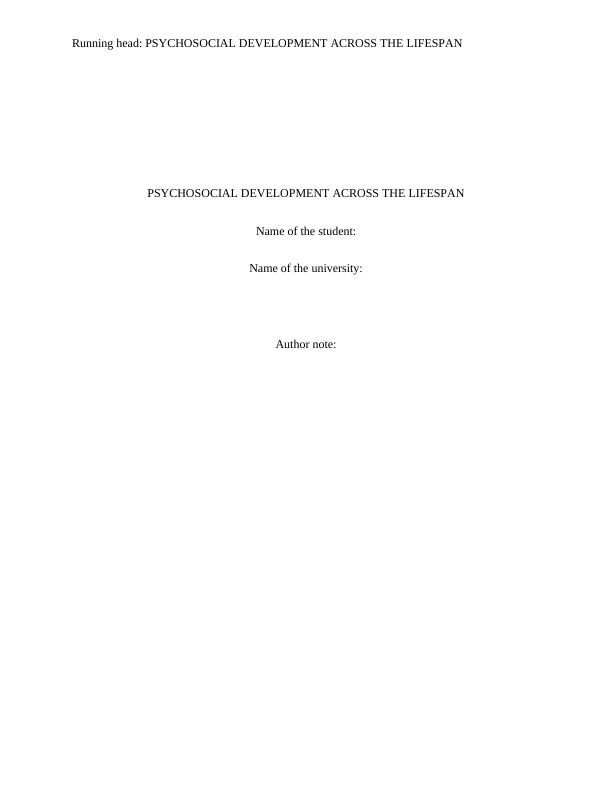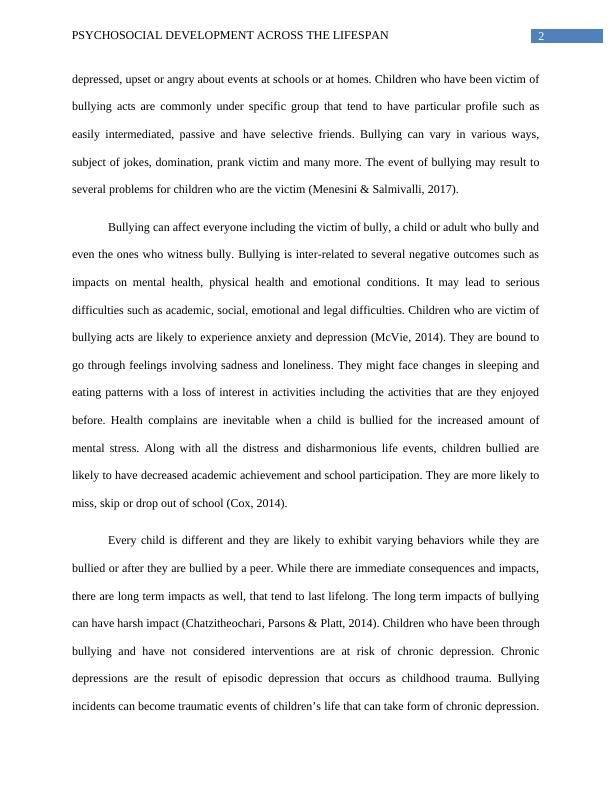Psychosocial Development Across the Lifespan
Added on 2023-01-18
7 Pages2091 Words45 Views
Running head: PSYCHOSOCIAL DEVELOPMENT ACROSS THE LIFESPAN
PSYCHOSOCIAL DEVELOPMENT ACROSS THE LIFESPAN
Name of the student:
Name of the university:
Author note:
PSYCHOSOCIAL DEVELOPMENT ACROSS THE LIFESPAN
Name of the student:
Name of the university:
Author note:

1PSYCHOSOCIAL DEVELOPMENT ACROSS THE LIFESPAN
Children go through several changes over the course of their lives. Humans experience
development through the lifespan from the birth till death. For years psychologists strive to
understand and explain the ways and the reasons people change throughout life (Katz, Lazarsfeld
& Roper, 2017). There are changes that are considered normal and they are expected changes in
the human life. However there are changes that still pose challenges that people sometimes need
extra assistance to manage. The paper aims to discuss the ways an experience impact
psychological development during that particular period of the lifespan. By considering bulling
in Adolescence between the ages of 11-20 years, the paper will discuss the above concern and
the ways relevant health professionals can promote well-being and minimize harm that is caused
to individuals who are impacted by the experience. The essay will include an description of the
experience, impacts of the psychosocial development in that particular period of life followed by
the ways health professionals can promote wellbeing and minimize the harm.
One of the common phenomenons found in school setting that many children and
adolescents come across is bullying mostly during 11 to 20 years. According to survey, as many
as half of all children experience bullying at some point of time during their school years and at
least 10 per cent are bulled on a regular basis. Bullying is a behavior that can be physical or
verbal. While boys tend to use more physical intimidation, girls tend to use more verbal bullying
(Juvonen & Graham, 2014). Bullying is also found in online platforms such as social media, and
email and on social networking sites. Children are bullied go through real suffering that can have
strong impact on their social and emotional development along with a major impact on their
school performance. Bullying can even lead students or children attempt to suicide rather than
enduring such harassment and punishment. Often children who have been bullied are the ones
who tend to bully other children. Children and adolescents who are bullied may also be
Children go through several changes over the course of their lives. Humans experience
development through the lifespan from the birth till death. For years psychologists strive to
understand and explain the ways and the reasons people change throughout life (Katz, Lazarsfeld
& Roper, 2017). There are changes that are considered normal and they are expected changes in
the human life. However there are changes that still pose challenges that people sometimes need
extra assistance to manage. The paper aims to discuss the ways an experience impact
psychological development during that particular period of the lifespan. By considering bulling
in Adolescence between the ages of 11-20 years, the paper will discuss the above concern and
the ways relevant health professionals can promote well-being and minimize harm that is caused
to individuals who are impacted by the experience. The essay will include an description of the
experience, impacts of the psychosocial development in that particular period of life followed by
the ways health professionals can promote wellbeing and minimize the harm.
One of the common phenomenons found in school setting that many children and
adolescents come across is bullying mostly during 11 to 20 years. According to survey, as many
as half of all children experience bullying at some point of time during their school years and at
least 10 per cent are bulled on a regular basis. Bullying is a behavior that can be physical or
verbal. While boys tend to use more physical intimidation, girls tend to use more verbal bullying
(Juvonen & Graham, 2014). Bullying is also found in online platforms such as social media, and
email and on social networking sites. Children are bullied go through real suffering that can have
strong impact on their social and emotional development along with a major impact on their
school performance. Bullying can even lead students or children attempt to suicide rather than
enduring such harassment and punishment. Often children who have been bullied are the ones
who tend to bully other children. Children and adolescents who are bullied may also be

2PSYCHOSOCIAL DEVELOPMENT ACROSS THE LIFESPAN
depressed, upset or angry about events at schools or at homes. Children who have been victim of
bullying acts are commonly under specific group that tend to have particular profile such as
easily intermediated, passive and have selective friends. Bullying can vary in various ways,
subject of jokes, domination, prank victim and many more. The event of bullying may result to
several problems for children who are the victim (Menesini & Salmivalli, 2017).
Bullying can affect everyone including the victim of bully, a child or adult who bully and
even the ones who witness bully. Bullying is inter-related to several negative outcomes such as
impacts on mental health, physical health and emotional conditions. It may lead to serious
difficulties such as academic, social, emotional and legal difficulties. Children who are victim of
bullying acts are likely to experience anxiety and depression (McVie, 2014). They are bound to
go through feelings involving sadness and loneliness. They might face changes in sleeping and
eating patterns with a loss of interest in activities including the activities that are they enjoyed
before. Health complains are inevitable when a child is bullied for the increased amount of
mental stress. Along with all the distress and disharmonious life events, children bullied are
likely to have decreased academic achievement and school participation. They are more likely to
miss, skip or drop out of school (Cox, 2014).
Every child is different and they are likely to exhibit varying behaviors while they are
bullied or after they are bullied by a peer. While there are immediate consequences and impacts,
there are long term impacts as well, that tend to last lifelong. The long term impacts of bullying
can have harsh impact (Chatzitheochari, Parsons & Platt, 2014). Children who have been through
bullying and have not considered interventions are at risk of chronic depression. Chronic
depressions are the result of episodic depression that occurs as childhood trauma. Bullying
incidents can become traumatic events of children’s life that can take form of chronic depression.
depressed, upset or angry about events at schools or at homes. Children who have been victim of
bullying acts are commonly under specific group that tend to have particular profile such as
easily intermediated, passive and have selective friends. Bullying can vary in various ways,
subject of jokes, domination, prank victim and many more. The event of bullying may result to
several problems for children who are the victim (Menesini & Salmivalli, 2017).
Bullying can affect everyone including the victim of bully, a child or adult who bully and
even the ones who witness bully. Bullying is inter-related to several negative outcomes such as
impacts on mental health, physical health and emotional conditions. It may lead to serious
difficulties such as academic, social, emotional and legal difficulties. Children who are victim of
bullying acts are likely to experience anxiety and depression (McVie, 2014). They are bound to
go through feelings involving sadness and loneliness. They might face changes in sleeping and
eating patterns with a loss of interest in activities including the activities that are they enjoyed
before. Health complains are inevitable when a child is bullied for the increased amount of
mental stress. Along with all the distress and disharmonious life events, children bullied are
likely to have decreased academic achievement and school participation. They are more likely to
miss, skip or drop out of school (Cox, 2014).
Every child is different and they are likely to exhibit varying behaviors while they are
bullied or after they are bullied by a peer. While there are immediate consequences and impacts,
there are long term impacts as well, that tend to last lifelong. The long term impacts of bullying
can have harsh impact (Chatzitheochari, Parsons & Platt, 2014). Children who have been through
bullying and have not considered interventions are at risk of chronic depression. Chronic
depressions are the result of episodic depression that occurs as childhood trauma. Bullying
incidents can become traumatic events of children’s life that can take form of chronic depression.

End of preview
Want to access all the pages? Upload your documents or become a member.
Related Documents
Psychosocial Development Across the Lifespanlg...
|6
|1777
|470
Bullying as a Health Issue: Effects on Children, Adolescents, and Familieslg...
|7
|1708
|91
Cyber Safety and Bullying Prevention Programslg...
|10
|2798
|20
Bullying in Adolescentlg...
|7
|2349
|80
Health Promotion Program for Bullying Reduction in Schoolslg...
|9
|2403
|81
Affect of Bullying in Australian Primary Schoolslg...
|16
|4076
|415
